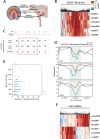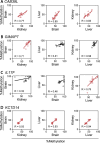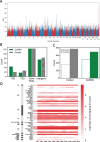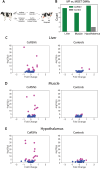Systemic interindividual DNA methylation variants in cattle share major hallmarks with those in humans
- PMID: 39004763
- PMCID: PMC11247883
- DOI: 10.1186/s13059-024-03307-6
Systemic interindividual DNA methylation variants in cattle share major hallmarks with those in humans
Abstract
Background: We recently identified ~ 10,000 correlated regions of systemic interindividual epigenetic variation (CoRSIVs) in the human genome. These methylation variants are amenable to population studies, as DNA methylation measurements in blood provide information on epigenetic regulation throughout the body. Moreover, establishment of DNA methylation at human CoRSIVs is labile to periconceptional influences such as nutrition. Here, we analyze publicly available whole-genome bisulfite sequencing data on multiple tissues of each of two Holstein cows to determine whether CoRSIVs exist in cattle.
Results: Focusing on genomic blocks with ≥ 5 CpGs and a systemic interindividual variation index of at least 20, our approach identifies 217 cattle CoRSIVs, a subset of which we independently validate by bisulfite pyrosequencing. Similar to human CoRSIVs, those in cattle are strongly associated with genetic variation. Also as in humans, we show that establishment of DNA methylation at cattle CoRSIVs is particularly sensitive to early embryonic environment, in the context of embryo culture during assisted reproduction.
Conclusions: Our data indicate that CoRSIVs exist in cattle, as in humans, suggesting these systemic epigenetic variants may be common to mammals in general. To the extent that individual epigenetic variation at cattle CoRSIVs affects phenotypic outcomes, assessment of CoRSIV methylation at birth may become an important tool for optimizing agriculturally important traits. Moreover, adjusting embryo culture conditions during assisted reproduction may provide opportunities to tailor agricultural outcomes by engineering CoRSIV methylation profiles.
Keywords: Bovine; CoRSIV; Cow; DoHAD; Systemic interindividual epigenetic variation.
© 2024. The Author(s).
Conflict of interest statement
The authors report no competing interests.
Figures




References
-
- VanRaden PM, Miller RH. The USDA Animal Improvement Programs Laboratory: A century old and just getting started. United States Department of Agriculture. AIPL Research Reports, 2008;HIST1(10-08).
-
- VanRaden PM, et al. Net merit as a measure of lifetime profit: 2021 revision. United States Department of Agriculture. AIP Research Report. 2021;NM$8(05-21).
-
- Cassell, B. Using Heritability for Genetic Improvement. 2001 22 September 2001; Available from: https://www.thecattlesite.com/articles/699/using-heritability-for-geneti....
MeSH terms
Grants and funding
LinkOut - more resources
Full Text Sources

